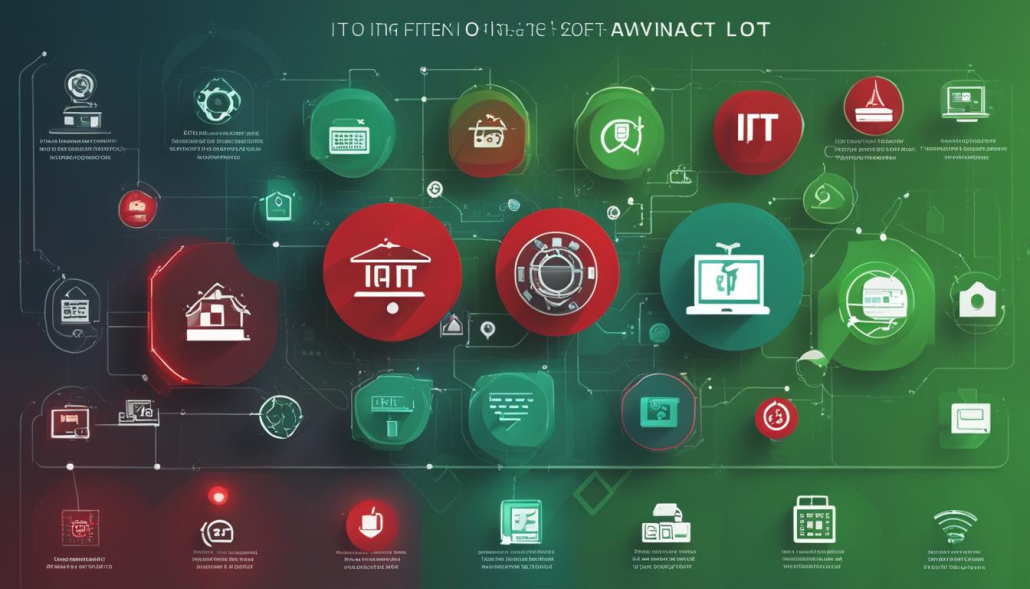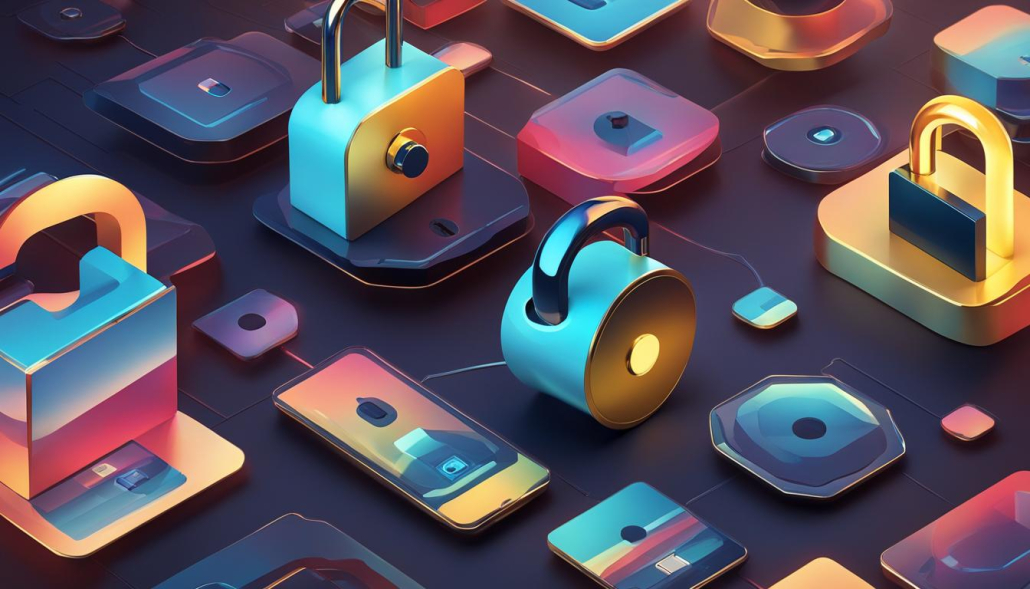Understanding What is the Internet of Things: An Insightful Guide
Welcome to our insightful guide on the Internet of Things (IoT). In this article, we will explore the definition of IoT and its significance in both consumer and business contexts. As technology continues to advance, understanding the IoT and its applications is crucial for individuals and organizations alike. Let’s delve into the world of IoT and discover its transformative potential.
Key Takeaways:
- The Internet of Things (IoT) refers to the integration of data analytics capabilities and internet connectivity with various objects.
- IoT has applications in a wide range of industries, including healthcare, smart homes, and industrial components.
- IoT improves daily life for consumers by providing convenience, automation, and personalized experiences.
- For businesses, IoT enables real-time monitoring, process optimization, and cost savings.
- While IoT offers numerous advantages, it is essential to address security concerns and implement robust cybersecurity measures.
History of IoT
The Internet of Things (IoT) has a rich history that dates back to the 1980s. The concept of embedding intelligence and sensors into physical objects was first proposed during this time. However, it wasn’t until the early 1990s when the first internet device, a toaster that could be controlled via the internet, was created. This marked a significant milestone in the development of IoT technology and set the stage for further advancements.
Throughout the 2000s, IoT continued to evolve with the introduction of RFID technology. This allowed objects to be uniquely identified and tracked using radio waves. Smart home gadgets, such as thermostats and security systems, also became more prevalent during this time. These advancements demonstrated the potential of IoT in improving daily life and sparked further interest in its development.
Today, IoT continues to progress at a rapid pace. The emergence of 5G networks has opened up new possibilities for IoT connectivity, enabling faster and more reliable data transmission. Additionally, the integration of IoT with blockchain technology has provided enhanced security and transparency for IoT applications. As IoT technology continues to evolve, we can expect even more exciting developments on the horizon.
Key Developments in IoT
| Year | Key Development |
|---|---|
| 1980s | Concept of embedding intelligence and sensors into objects proposed |
| 1990s | Creation of the first internet device – a toaster controlled via the internet |
| 2000s | Introduction of RFID technology and smart home gadgets |
| Present | Advancements in 5G networks and integration of IoT with blockchain technology |
“The history of IoT showcases the continuous innovation and advancements in the field. From the early days of internet-connected toasters to the current integration of IoT with cutting-edge technologies, IoT has come a long way. We are now entering an era where the possibilities of IoT are limitless, and it will undoubtedly play a significant role in shaping the future.”
How does the Internet of Things (IoT) work?
The Internet of Things (IoT) operates through a complex ecosystem consisting of interconnected devices, a central gateway, and cloud computing. It enables seamless communication and data exchange between various smart devices, transforming the way we interact with technology. Let’s dive into the key components of the IoT ecosystem to understand how it works.
IoT Devices
IoT devices are the building blocks of the system. These web-enabled smart devices, equipped with sensors and processors, collect data from the physical world. They can range from wearables like fitness trackers to industrial sensors and household appliances. IoT devices communicate with each other and perform automated actions based on the data they receive.
IoT Gateway
The IoT gateway serves as a central hub that connects the devices to the cloud. It acts as a bridge between the devices and the cloud infrastructure, enabling data transmission and communication. The gateway plays a crucial role in managing and securing the flow of data between the devices and the cloud.
Data Processing in the Cloud
The data collected from the IoT devices is sent to the cloud for processing and analysis. In the cloud, the data is stored, aggregated, and analyzed to generate meaningful insights. Advanced analytics techniques, such as machine learning and artificial intelligence, can be applied to extract valuable information from the massive amount of data generated by IoT devices.
| IoT Ecosystem |
|---|
| https://www.youtube.com/watch?v=Wt6KSWClkQE |
The Internet of Things (IoT) is revolutionizing industries and our daily lives by connecting devices, collecting data, and enabling automation. Through an ecosystem of interconnected devices, an IoT gateway, and cloud computing, the IoT transforms how we interact with technology. This powerful system has the potential to unlock new possibilities and drive innovation in various sectors.
Understanding how the IoT operates is essential for organizations and individuals looking to leverage its benefits. By harnessing the power of IoT devices, utilizing robust gateway solutions, and leveraging cloud-based analytics, we can unlock the full potential of the Internet of Things and drive meaningful transformation in our digital world.
Why is IoT important?
The Internet of Things (IoT) has become increasingly important in both consumer and business contexts. Its transformative potential lies in the seamless integration of devices, data, and analytics, enabling a multitude of benefits and opportunities.
For consumers, IoT devices offer convenience, automation, and personalized experiences. From smart thermostats that adjust temperature based on preferences to wearable fitness trackers that monitor health and provide real-time feedback, IoT enhances daily life for individuals. Connected devices in smart homes enable remote control of lighting, security systems, and appliances, promoting energy efficiency and comfort.
In the business world, IoT brings significant value by enabling real-time monitoring, optimization, and automation. Industries such as manufacturing, logistics, and agriculture can leverage IoT to improve operational efficiency, reduce costs, and enhance decision-making. For example, IoT sensors embedded in machinery can provide real-time data on performance and maintenance needs, allowing for predictive maintenance and minimizing downtime.
| Benefits of IoT for Consumers | Benefits of IoT for Businesses |
|---|---|
|
|
IoT has the potential to transform industries and create new business models. By collecting and analyzing vast amounts of data from connected devices, organizations can gain valuable insights into customer behavior, product performance, and market trends. These insights drive innovation, inform strategic decision-making, and enable the development of new products and services.
The importance of IoT lies in its ability to unlock new opportunities, drive efficiency, and improve lives. As technology continues to advance, it is crucial for both individuals and organizations to embrace IoT and harness its full potential in order to stay competitive and thrive in the digital age.
What are the pros and cons of IoT?
As with any technology, the Internet of Things (IoT) comes with both advantages and disadvantages. Understanding the pros and cons can help us make informed decisions about implementing and utilizing IoT in various aspects of our lives.
Advantages of IoT:
- Improved access to information: IoT devices enable us to gather and analyze data in real-time, providing valuable insights and enhancing decision-making processes.
- Enhanced communication between devices: With IoT, devices can seamlessly communicate with each other, enabling automation, coordination, and synchronization of tasks.
- Automation of tasks: IoT devices can automate routine tasks, making our lives more convenient and efficient. For example, smart thermostats can adjust temperature settings based on our preferences and occupancy.
- Better healthcare services: IoT enables remote monitoring of patients’ health conditions, allowing healthcare professionals to provide timely interventions and personalized care.
Disadvantages of IoT:
- Increased security risks: IoT devices are vulnerable to cyberattacks, which can compromise our privacy and safety. It is essential to implement robust security measures to protect against unauthorized access and data breaches.
- Compatibility issues between devices: IoT devices from different manufacturers may have compatibility issues, making it challenging to integrate and optimize their functionalities.
- Potential for unauthorized access to personal data: As IoT devices collect and transmit data, there is a risk of personal information being accessed by unauthorized individuals or organizations. Protecting our data privacy is crucial in the IoT era.
By evaluating the advantages and disadvantages of IoT, we can make informed decisions and take appropriate measures to maximize its benefits while mitigating potential risks. Implementing strong security protocols, ensuring compatibility between devices, and being mindful of data privacy are essential steps in harnessing the full potential of IoT.
| Advantages of IoT | Disadvantages of IoT |
|---|---|
| Improved access to information | Increased security risks |
| Enhanced communication between devices | Compatibility issues between devices |
| Automation of tasks | Potential for unauthorized access to personal data |
| Better healthcare services |
What are IoT platforms?
IoT platforms are crucial for creating and managing IoT applications. These platforms provide a comprehensive framework for developing, testing, and maintaining multiple applications, integrating with existing systems, managing data, and ensuring security. By connecting and analyzing data from various endpoints and devices, organizations can leverage the full potential of IoT.
“An effective IoT platform acts as a bridge between devices, data, and applications, enabling seamless communication and interaction.”
IoT platforms offer a range of features and capabilities, such as device management, data analytics, and application development tools. They provide a centralized interface for controlling and monitoring IoT devices, collecting and processing data, and creating customized applications. With these platforms, organizations can efficiently deploy and manage their IoT solutions, accelerate time-to-market, and scale their deployments as needed.
| Benefits of IoT platforms | Examples of IoT platforms |
|---|---|
|
|
| Considerations for selecting an IoT platform | Key features to look for in an IoT platform |
|
|
Choosing the right IoT platform is crucial for successful implementation and utilization of IoT technology. Organizations need to consider factors such as scalability, interoperability, and security when selecting an IoT platform that aligns with their specific needs and objectives. With the right platform in place, businesses can harness the full potential of IoT and drive innovation in their industries.
What should I know about IoT security?
Ensuring the security of IoT devices and networks is crucial in today’s interconnected world. As the Internet of Things (IoT) continues to grow, so do the potential risks and vulnerabilities that can be exploited by malicious actors. Organizations and individuals must be proactive in implementing robust cybersecurity measures to protect sensitive data and prevent unauthorized access to IoT systems.
To enhance IoT security, it is essential to understand the industry-specific risks and challenges. Different sectors may face unique threats, such as healthcare organizations dealing with patient data privacy or manufacturing facilities safeguarding intellectual property. By identifying and addressing these specific risks, organizations can develop tailored security strategies to mitigate potential vulnerabilities.
Collaboration among regulators, industry players, and stakeholders is also crucial in addressing IoT security challenges. Sharing best practices, threat intelligence, and standards can help establish a collective effort to enhance security measures and respond effectively to emerging threats. Governments and regulatory bodies should play a significant role in creating guidelines and regulations that promote IoT security and hold organizations accountable for maintaining robust security practices.
Creating comprehensive security measures
Creating comprehensive security measures throughout the product lifecycle is essential in maintaining the integrity and safety of IoT systems. This includes implementing strong access controls, encrypting data in transit and at rest, regularly updating and patching devices, and conducting thorough security testing and audits.
Furthermore, organizations should establish clear roles and responsibilities for IoT security within their respective teams. Having dedicated personnel responsible for monitoring, detecting, and responding to security incidents can help ensure a proactive approach to cybersecurity. Continuous training and awareness programs for employees should also be implemented to promote a security-conscious culture throughout the organization.
In conclusion, IoT security is a pressing concern, and organizations need to prioritize it to safeguard their systems and data. By understanding industry-specific risks, collaborating with regulators and industry players, and implementing comprehensive security measures, organizations can mitigate the potential risks associated with IoT devices and networks. It is crucial to stay vigilant and proactive in addressing emerging threats and evolving security challenges to ensure the safe and secure operation of IoT systems.
What is IIoT?
The Industrial Internet of Things (IIoT) is a subset of IoT that focuses on the application of IoT technology in industrial settings. It brings together the power of connected devices, sensors, and analytics to optimize manufacturing processes, improve efficiency, and enable predictive maintenance in sectors like manufacturing, energy, and transportation. The goal of IIoT is to leverage advanced technologies to transform traditional industries, driving digital transformation and innovation in the industrial sector.
IIoT enables the collection and analysis of large amounts of data from various industrial devices and equipment, allowing businesses to gain valuable insights and make data-driven decisions. By connecting machines and systems, IIoT enables real-time monitoring, remote control, and automation of industrial operations, leading to increased productivity, reduced downtime, and improved safety.
One of the key advantages of IIoT is its ability to enable predictive maintenance. By leveraging data from sensors and analytics, IIoT can detect potential equipment failures or maintenance needs before they occur. This allows businesses to schedule maintenance activities more efficiently, reducing unplanned downtime and optimizing maintenance costs.
Key Features of IIoT:
- Connectivity: IIoT relies on robust connectivity, including wired and wireless networks, to enable seamless communication between devices and systems.
- Interoperability: IIoT systems are designed to integrate with existing industrial infrastructure, enabling compatibility between different devices and platforms.
- Data Analytics: IIoT leverages advanced analytics and machine learning algorithms to process and analyze large volumes of data, providing valuable insights for decision-making.
- Security: Given the critical nature of industrial operations, IIoT places a strong emphasis on cybersecurity to protect against potential threats and data breaches.
IIoT is a vital component of Industry 4.0, also known as the Fourth Industrial Revolution. The integration of IoT technology in industrial settings is driving significant advancements and reshaping the way industries operate. With the continued adoption of IIoT, we can expect increased automation, improved efficiency, and enhanced productivity in various industrial sectors.
Conclusion
The Internet of Things (IoT) has transformed the way we interact with technology and objects around us. From wearables and smart homes to healthcare and industrial components, IoT has the potential to revolutionize industries and bring significant value to businesses and the global economy.
While there are challenges and security concerns to address, the benefits of IoT are significant. IoT devices improve daily life by providing convenience, automation, and personalized experiences for consumers. For businesses, IoT enables real-time monitoring and optimization of processes, leading to increased efficiency, cost savings, and better decision-making.
As IoT continues to advance, it will shape the future of technology, connectivity, and automation. It will drive innovation, create new opportunities, and further integrate into our daily lives. Organizations and individuals need to embrace IoT and harness its full potential to thrive in the evolving digital landscape.
FAQ
What is the Internet of Things (IoT)?
The Internet of Things (IoT) refers to the integration of data analytics capabilities and internet connectivity with various objects, allowing them to generate, exchange, and consume data with little human involvement.
What is the history of IoT?
The concept of IoT can be traced back to the 1980s when the idea of embedding intelligence and sensors into physical objects was proposed. Over the years, several milestones were achieved in the development of IoT technology.
How does the Internet of Things (IoT) work?
In an IoT ecosystem, web-enabled smart devices collect and send data to an IoT gateway, which acts as a central hub connecting the devices to the cloud. The data collected is then processed and analyzed in the cloud, enabling devices to communicate with each other and perform automated actions.
Why is IoT important?
IoT improves daily life for consumers by providing convenience, automation, and personalized experiences. For businesses, it enables real-time monitoring and optimization of processes, leading to increased efficiency, cost savings, and better decision-making.
What are the pros and cons of IoT?
IoT offers advantages such as improved access to information, enhanced communication, task automation, and better healthcare services. However, there are also challenges and disadvantages associated with IoT, such as security risks, compatibility issues, and unauthorized access to personal data.
What are IoT platforms?
IoT platforms are essential for creating and managing IoT applications. They provide a framework for developing, testing, and maintaining multiple applications, integrating with existing systems, managing data, and ensuring security.
What should I know about IoT security?
IoT security is crucial to protect against vulnerabilities and attacks. Organizations should prioritize IoT security by understanding industry-specific risks, establishing clear roles and responsibilities, collaborating with regulators and industry players, and implementing comprehensive security measures.
What is IIoT?
The Industrial Internet of Things (IIoT) is a subset of IoT that focuses on the application of IoT technology in industrial settings. It leverages IoT devices, sensors, and analytics to optimize manufacturing processes, improve efficiency, and enable predictive maintenance.
- About the Author
- Latest Posts
Mark is a senior IT technician at Biteno.com . He writes about Linux, Windows and Software.



